- home
- BAKERECIPES
BakeRecipes
Bringing real baking into your home with deliciously simple recipes.
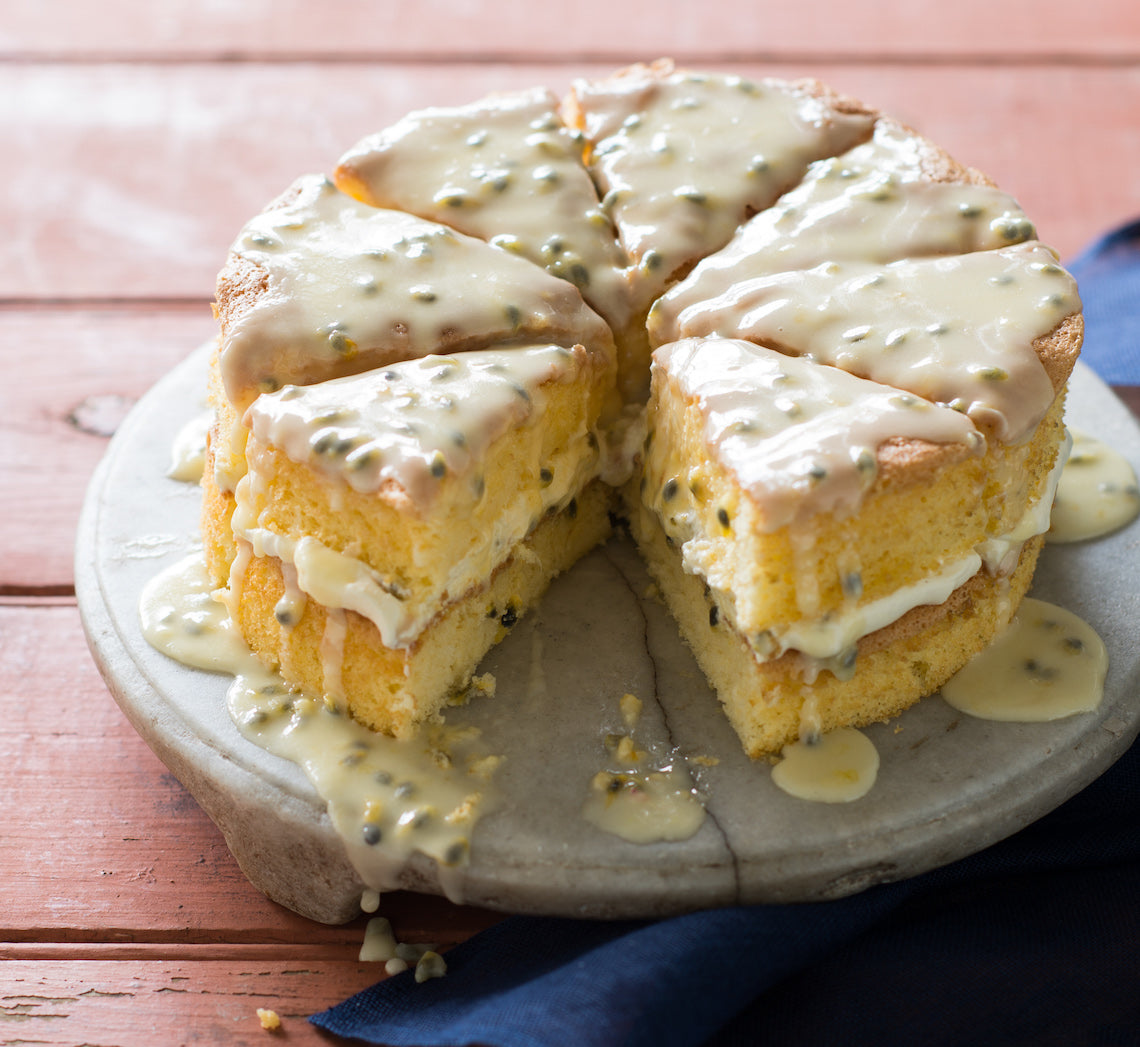
Prep 25min (+cooling time)Bake 18-20minMakes 8-10 serves
This sponge will have you wanting an excuse to make afternoon tea every day. There are two main tricks when making a sponge: don’t over-whisk the mixture once you have added the flour – only whisk it until the mixture is just combined. Also, sponges don’t take long to bake and, if overcooked, will easily become dry, so keep a close eye on them when baking.
Ingredients
160ml (⅔ cup/5¼fl oz) thickened cream
80ml (⅓ cup/2½fl oz) fresh passionfruit pulp
Sponge Layers
Melted butter, to grease
4 x 60g (2oz) fresh eggs, at room temperature
165g (¾ cup/5¾oz) caster sugar
60ml (¼ cup/2fl oz) milk
30g (1oz) salted butter, diced
110g (¾ cup/4oz) self-raising flour, plus extra to dust
30g (¼ cup/1oz) cornflour
Passionfruit Icing
180g (1½ cups/6½oz) pure icing sugar
1½ tablespoons fresh passionfruit pulp
Approx. 3 teaspoons boiling water
Method
- To make the Sponge Layers, place the oven rack in the lower third of the oven and then preheat it to 180°C/350°F (160°C/315°F fan-forced). Brush two 20cm/8in shallow (sandwich) cake tins with a little melted butter to lightly grease. Line the bases with circles of baking paper. Lightly brush the paper with a little more melted butter and then dust the bases and sides of the tins with a little flour to lightly coat, tapping out any excess.
- Use an electric mixer with a whisk attachment on medium-high speed to whisk the eggs in a medium bowl until frothy. Add the sugar a spoonful at a time, whisking well between each addition, until the mixture is very thick and pale and the sugar has dissolved (this will take about 8 minutes). Lift the whisk out of the mixture and draw a figure eight, if the trail stays on the surface long enough for you to finish drawing then the mixture is ready. If not, continue to whisk for a further minutes and then test again.
- Meanwhile, heat the milk and butter in a small saucepan over medium heat until the butter melts and the mixture is almost simmering. Remove from the heat. Pour the hot milk mixture down the side of the bowl with the egg mixture. Quickly sift the flour and cornflour together over the egg mixture and then immediately whisk again with the electric mixer briefly, until the flour mixture is just incorporated (make sure there is no flour caught at the bottom of the bowl and be careful not to overmix).
- Divide the mixture evenly between the cake tins (see Baker’s Tips) and gently tap the tins on the bench top three times to settle the mixture. Bake in preheated oven for 18-20 minutes or until the cakes are a pale golden colour, spring back when lightly touched in the centre and start pulling away from the sides of the tins. Remove from the oven and stand for 1 minute before turning onto a wire rack, top side up (see Baker’s Tips), to cool completely.
- When ready to fill, to make the Passionfruit Icing, sift the icing sugar into a medium bowl. Add the passionfruit pulp and enough boiling water to mix to a thin, spreadable icing. Cover tightly with plastic wrap and set aside. Use an electric mixer with a whisk attachment or a balloon whisk to whisk the cream in a medium mixing bowl until soft peaks form. Use a large metal spoon or spatula to gently fold the passionfruit pulp through the whipped cream until just swirled through. Place one layer of the sponge on a serving plate or cake stand and spread with the passionfruit cream. Top with the remaining sponge layer. Spread the Passionfruit Icing evenly over the top layer of the sponge, allowing it to drip down the sides slightly. Set aside or 20 minutes or until the icing sets before serving in slices.
Baker's Tips
- You will need about 5 large passionfruit for this recipe.
- To divide the mixture evenly between the tins, weigh the tins with the mixture in them to make sure they are the same weight.
- When removing the cakes from the tins, turn them onto a wire rack covered with a tea towel before inverting onto another rack. The tea towel will prevent the rack marking the tops of the cakes.
- The unfilled sponge cakes will keep in an airtight container at room temperature for up to 1 day. Once filled, the cake will keep in an airtight container in the fridge for up to 2 days. Stand at room temperature for at least 30 minutes before serving.
This recipe is from Anneka's SBS Food online column, Bakeproof: Sponge Cake.
CLICK HERE for more Bakeproof recipes.
Photography by Alan Benson.
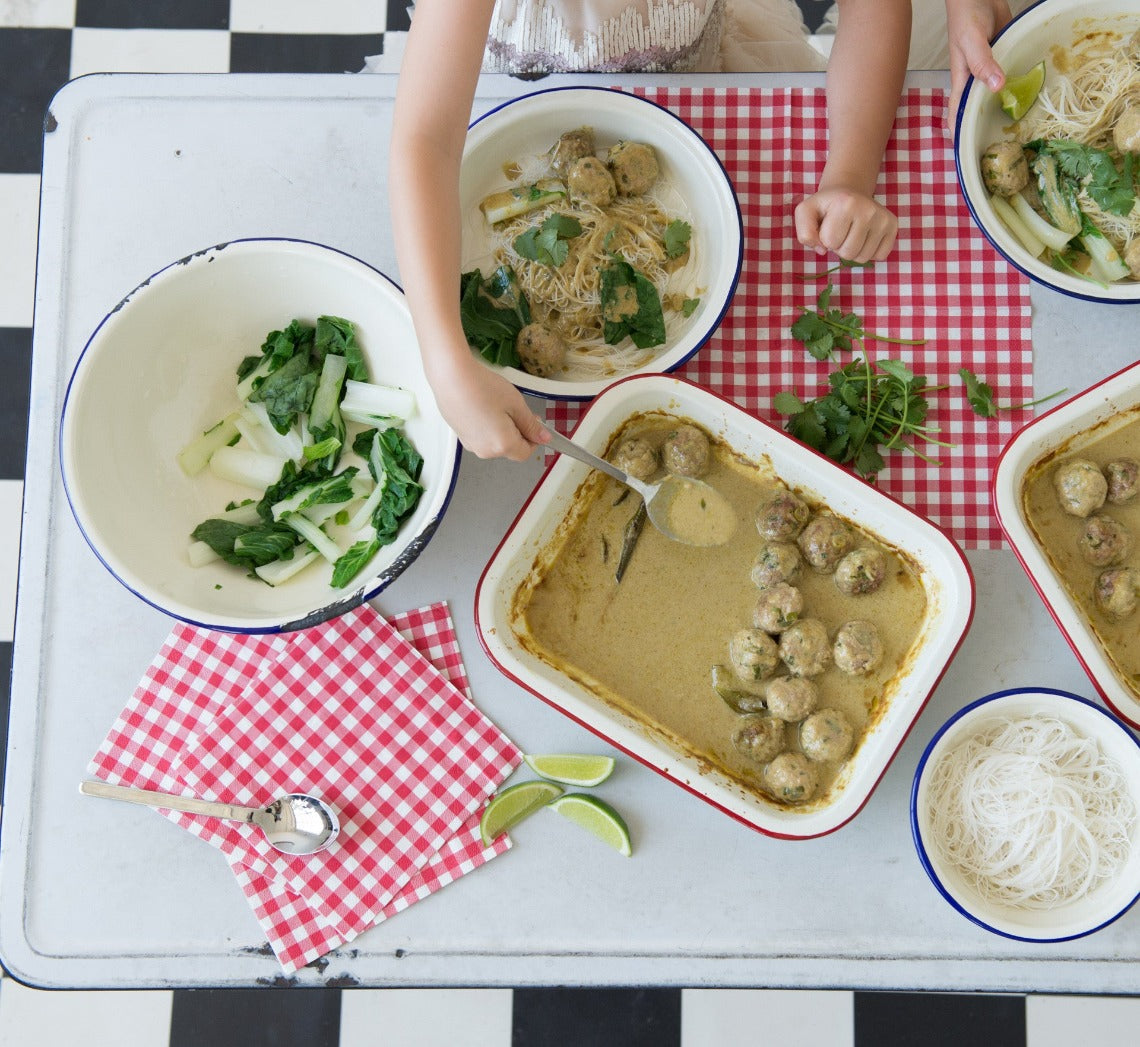
Prep 30minBake 30minMakes 4-6 serves
Any recipe that gets kids rolling balls of mixture will help develop their fine motor skills no matter what their age. Fun to make, these meatballs also encourage independence — put all the components in the middle of the table for everyone to help themselves.
Ingredients
200g dried rice vermicelli, cooked according to packet directions
fresh coriander leaves, lime wedges and steamed asian greens, to serve
Meatballs
500g pork and veal mince (see Baker's Tips)
18g (⅓ cup) panko rice crumbs
2 tablespoons milk
3 teaspoons finely grated fresh ginger
1½ tablespoons finely chopped drained canned water chestnuts
5 green shallots, thinly sliced
⅓ cup finely chopped coriander
Sauce
2 teaspoon peanut oil
3 tablespoons good-quality green curry paste, or to taste (see Baker's Tips)
125ml (½ cup) good-quality chicken stock
500ml (1 cup) water
440ml can coconut milk
4 kaffir lime leaves
2 teaspoons fish sauce, or to taste
1 tablespoon lime juice, or to taste
2 teaspoon grated palm or brown sugar, or to taste
Method
- Preheat oven to 180°C (160°C fan-forced).
- Combine the mince, crumbs, milk, ginger, water chestnuts, green shallots and coriander in a large bowl and mix well with your hands until thoroughly combined. Use damp hands to roll 2 teaspoonfuls of the mixture into balls and place in one layer in a shallow 20cm x 30cm/2.5 litre (10 cup) capacity ovenproof dish. Cover and place in the fridge while making the sauce.
- To make the sauce, combine the peanut oil and curry paste in a medium saucepan and cook over medium-high heat for 2-3 minutes, stirring occasionally, or until aromatic. Add the stock, coconut milk, kaffir lime leaves, fish sauce, lime juice and sugar and bring just to a simmer over medium heat.
- Pour the sauce over the meatballs. Bake in the preheated oven for 30 minutes or until the meatballs are just cooked through. Taste the sauce and adjust seasoning with extra fish sauce, lime just and sugar if desired.
- Divide the noodles among four bowls and spoon over the meatballs and some of the sauce. Top with coriander leaves and serve with lime wedges and steamed Asian greens.
Baker's Tips
- You can also use just pork mince for this recipe.
- You may find you need to use a little less or add a little more green curry paste depending on the brand you use as they can vary greatly in flavour and heat intensity. Keep also in mind your childrens' flavour preferences as you don’t want to make it too hot for their sensitive tastebuds.

Prep 40min (+ 40min cooling and 20min chilling time)Bake 20minMakes 6 large lamingtons
Rich, decadent, indulgent and insanely large these lamingtons are perfect to serve as a dessert with fresh raspberries or to share with another chocolate lover (but only if you can part with the other half)!
Ingredients
330g (11⅔oz/6 cups) flaked coconut, to coat
Chocolate Buttercake
185g (6½oz/1¼ cups) plain flour
55g (2oz/½ cup) cocoa powder
3 teaspoons baking powder
275g (9¾oz/1¼ cups, firmly packed) brown sugar
125g (4½oz) salted butter, cubed, softened
2 eggs, at room temperature
160ml (5¼fl oz/⅔ cup) water
2 teaspoons natural vanilla extract or essence
Raspberry Swirl Cream
100ml (3½fl oz) pure (thin/pouring) cream
85g (3oz/¼ cup) raspberry jam
2 teaspoons raspberry liqueur (Chambord) or water
Chocolate Ganache
200g (7oz) good-quality dark chocolate (45-54% cocoa), chopped
300ml (10½fl oz) pure (thin / pouring) cream
Method
- To make the Chocolate Buttercake, preheat the oven to 180°C/350°F (160°C/315°F fan-forced). Grease a 20cm x 30cm (8in x 12in), base measurement, shallow cake tin and line the base and two long sides with one piece of baking paper.
- Sift together the flour, cocoa and baking powder in a large mixing bowl. Add the sugar, butter, eggs, water and vanilla in a large mixing bowl. Use an electric mixer to beat on low speed until combined. Increase the speed to medium and beat for 3 minutes or until the mixture is well combined, creamy and pale in colour. Pour the mixture into the lined tin and spread evenly using the back of a spoon.
- Bake for 20 minutes or until a skewer inserted in the centre comes out clean. Cool for 5 minutes in the tin, then turn onto a wire rack to cool completely (this will take about 40 minutes).
- To make the Raspberry swirl cream, use a balloon whisk or an electric mixer with a whisk attachment to whisk the cream on medium speed until firm peaks form. Stir together the jam and liqueur or water to thin the jam, add to the cream and use a metal spoon or a spatula to swirl the jam through the cream. Cover and chill until needed.
- Trim the edges of the cooled cake and then cut in half to form two portions, each about 15cm x 20cm (6in x 8in). Spread one portion of the cake with the Raspberry Swirl Cream and top with the remaining cake portion. Chill for 20 minutes or until the cream is firm enough to cut the cake.
- Meanwhile, to make the Chocolate ganache, put the chocolate in a heatproof bowl. Bring the cream just to a simmer in a small saucepan. Pour the hot cream over the chocolate and stir with a metal spoon until the chocolate melts and the mixture is smooth.
- Use a sharp serrated knife to cut the layered cake into 6 large portions, about 6.5cm x 7.5cm (2½in x 3in) each. Run a small palette knife around the cut surface of each lamington to remove any excess cream.
- Spread the coconut on a tray or plate. Rest a cake square on a fork, carefully dip into the ganache and then and spoon the ganache over the top and sides to completely coat (see Baker's Tips). Allow any extra ganache to drip off. Roll the cake in the coconut to coat evenly. Place on a wire rack. Repeat with the remaining cake portions, ganache and coconut.
Baker's Tips
- The ganache should be the consistency of thickened cream when coating the lamingtons. If it becomes too thick while you are coating the cake pieces, sit the bowl over a saucepan of simmering water (don't let the water touch the bottom of the bowl though), and stir until it comes back to the right consistency.
- These lamingtons will keep in an airtight container in the fridge, for up to 3 days. Stand at room temperature for about 30 minutes before serving.
Photography by Alan Benson.
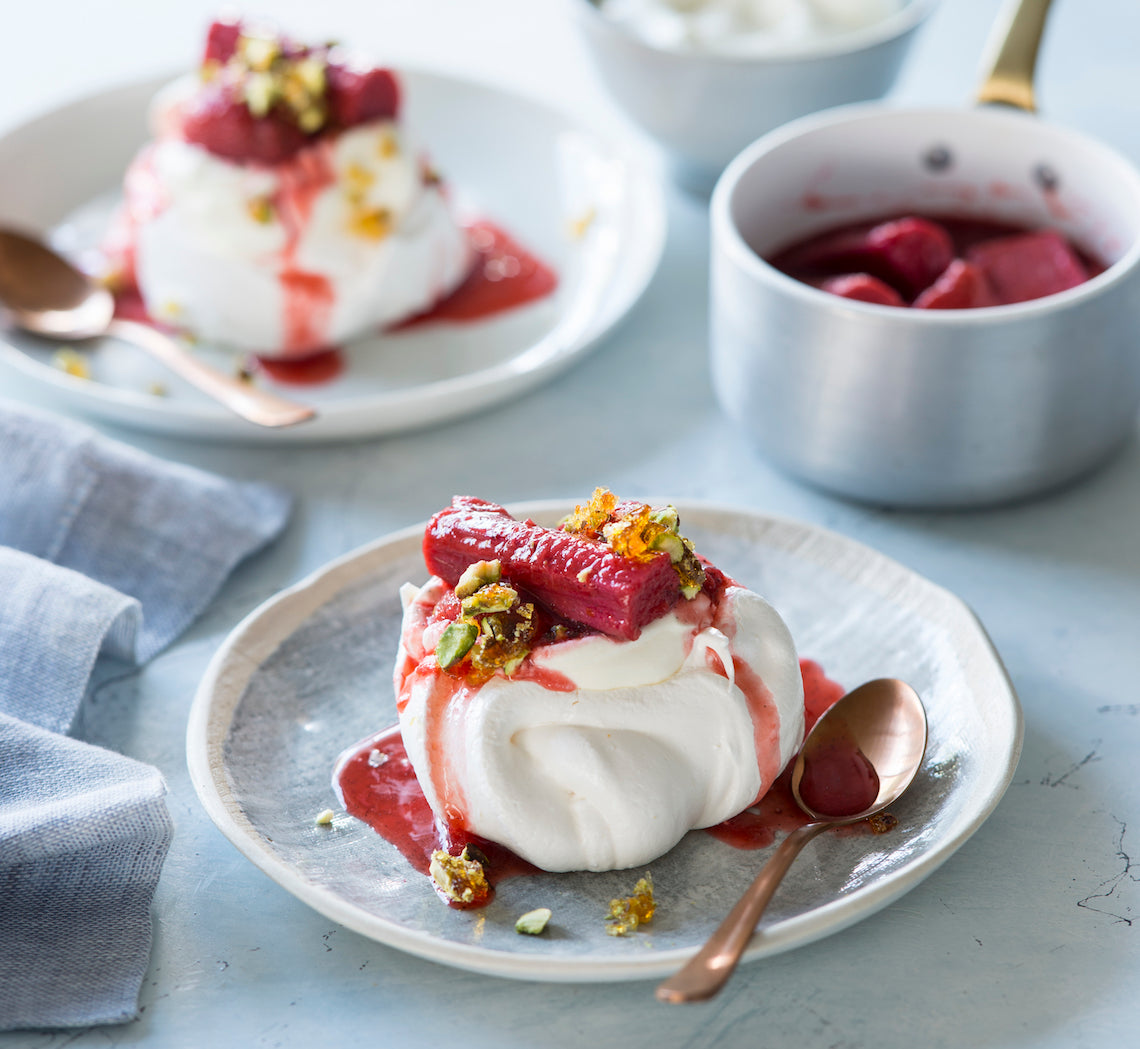
Prep 1hr (+2hr cooling time)
Bake 1hr 35minMakes 8 serves
Delicately flavoured with rosewater, these individual pavlovas make a divine create-your-own dessert. Those who prefer a slightly more casual approach to assembly can opt for an Eaton mess. Simply crush the pavlovas and layer the individual elements in a glass instead!
Ingredients
lime wedges, to serve
Rosewater pavlovas
3 egg whites, at room temperature
165g (¾ cup) caster sugar
2 teaspoons cornflour, sifted
2 teaspoons rosewater
Vanilla-roasted red fruits
500g trimmed rhubarb (about 2 bunches), cut into 6 cm lengths
2 x 250g punnets small strawberries, hulled
2 vanilla beans, split lengthways
150g (⅔ cup) caster sugar
Yoghurt cream
125ml (½ cup) thickened cream, whipped to firm peaks
130g (½ cup) thick Greek-style natural yoghurt
Toffee pistachios
110g (½ cup) caster sugar
60ml (¼ cup) water
75g unsalted pistachio kernels, toasted
Method
- To make the rosewater pavlovas, place the oven rack in the lower third of the oven and preheat it to 110°C. Line an oven tray with non-stick baking paper. Use an electric mixer with a whisk attachment to whisk the egg whites in a large bowl on medium-high speed until soft peaks form. With the motor running, add the sugar a spoonful at a time, whisking well after each addition, until all the sugar has dissolved and the mixture is very thick and glossy (this will take 4-5 minutes). Add the cornflour and rosewater and whisk to combine. Use a spatula to stir the meringue mixture to ‘loosen’ it slightly (this will get rid of any excess air in the mixture and give it a smoother, less ‘foamy’ texture). Use two metal tablespoons to spoon 8 ovals of the meringue mixture on to the lined tray and use the back of a spoon to make in an indent in the centre of each. Bake in the lower third of the preheated oven for 1 hour 15 minutes, until the meringue is crisp and hard to touch, but not coloured. Turn off the oven, leave the door slightly ajar and cool it completely in the oven (this will take about 2 hours).
- To make the toffee pistachios, line an oven tray with non-stick baking paper. Combine the caster sugar and water in a small saucepan and use a wooden spoon to stir over low heat until the sugar dissolves. Increase the heat to medium and bring to the boil. Boil for 8-10 minutes, brushing down the side of the pan with a pastry brush dipped in water to dissolve any sugar crystals, until the mixture turns a deep caramel. Pour immediately onto the lined tray and then sprinkle with the pistachios. Lightly tap the tray 2-3 times on the bench top to settle the pistachios into the toffee and then set aside to cool completely (this will take about 30 minutes). When cool, use the end of a rolling pin to pound the toffee into coarse chunks.
- To make the vanilla-roasted red fruits, preheat the oven to 200°C (180°C fan-forced). Rinse the rhubarb and shake off any excess water. Place in a bowl with the strawberries and sugar. Use a small sharp knife to scrape the seeds from the vanilla bean. Add the bean and the seeds to the rhubarb mixture and toss to combine. Transfer to an ovenproof dish just large enough to hold the fruit in a single layer and cover with foil. Bake in preheated oven for 18-20 minutes or until the rhubarb is just tender and still holding its shape. Remove the foil and set aside to cool.
- To make the yoghurt cream, fold together the whipped cream and yoghurt.
- To serve, place the pavlovas, toffee pistachios, roasted fruit, yoghurt cream and lime wedges in the centre of the table for guests to assemble their own dessert.
Baker's Tips
- The rosewater pavlovas will keep in an airtight container at room temperature for up to 1 week.
- The vanilla-roasted red fruit will keep in an airtight container in the fridge for up to 3 days. Serve at room temperature.
- The toffee pistachios will keep in a sealed jar or airtight container at room temperature for up to 1 month. You may have to pound again to break up before serving.
Photography by Alan Benson. Styling by Jane Hann.
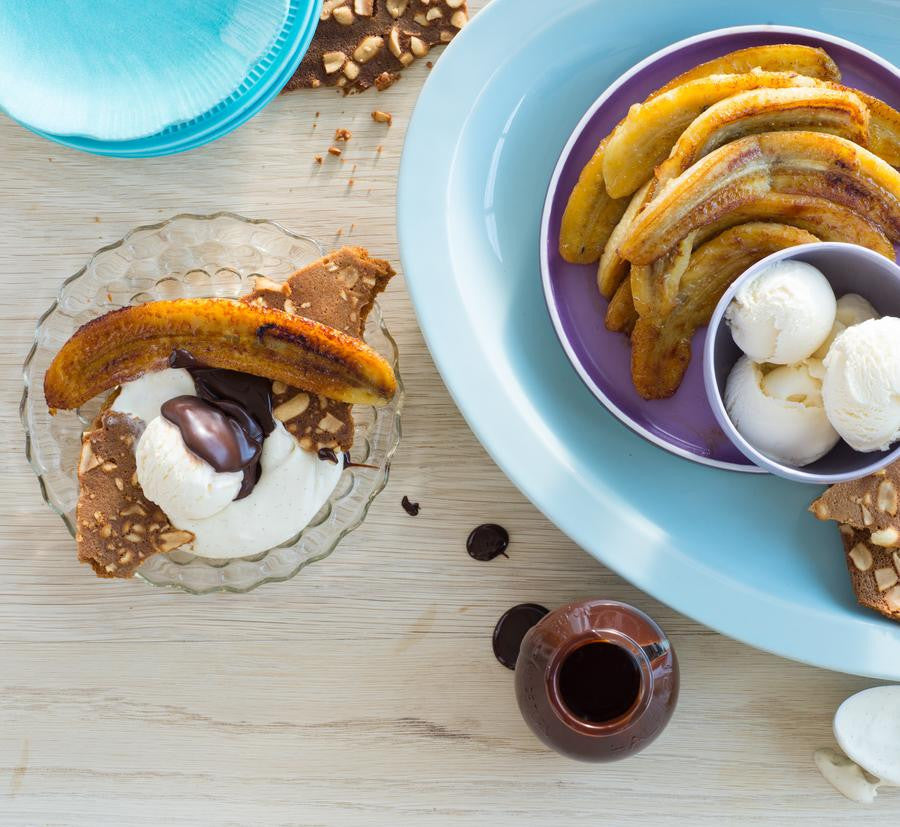
Prep 40min (+ 30min cooling time)
Bake 25minMakes 6 serves
A childhood classic given a modern twist, this fruity split is the perfect dessert to share with a crowd. Place all the separate elements in the centre of the table and arm your guests with their own bowl and spoon. Ready, set, go!
Ingredients
1 x 500ml (17fl oz) tub good–quality vanilla ice-cream, to serve
Salted peanut honey wafers
35g (¼ cup/1¼oz) plain flour
55g (¼ cup/2oz) caster sugar
85g (¼ cup/3oz) honey, warmed slightly
50g (1¾oz) unsalted butter, melted and cooled
1 egg white
100g (3½oz) salted roasted peanuts, very coarsely chopped
Chocolate fudge sauce
185g (6½oz) good-quality dark chocolate (45-54% cocoa), chopped
185ml (¾ cup/6½fl oz) pouring cream
1 tablespoon (4 teaspoons) honey
Caramelised Honeyed Banana
6 firm, ripe bananas (about 170g/6oz each)
20g (¾oz) salted butter, diced
2 tablespoons (8 teaspoons) honey
Chantilly cream
150ml (5fl oz) thickened cream
1 teaspoon vanilla bean paste
1½ tablespoons (6 teaspoons) icing sugar
Method
- To make the Honey and peanut wafers, preheat the oven to 150°C/300°F (130°C/265°F fan-forced). Line a large oven tray with non-stick baking paper. Place the flour and sugar in a medium bowl. Combine the honey, butter and egg white, add to the dry ingredients and use a balloon whisk to stir until just combined and smooth. Pour the mixture onto the lined tray and use the back of a spoon to spread the mixture evenly as evenly as possibly into a thin 25cmx30cm/10inx12in rectangle. Sprinkle evenly with the peanuts. Bake in the centre of the preheated oven for 25 minutes, turning the tray around after 15 minutes to help bake evenly, or until dark golden and the centre is cooked through. Remove from the oven and cool on the tray (this will take about 30 minutes). Break into large pieces and set aside.
- To make the Chantilly cream, combine the cream, icing sugar and vanilla in a medium bowl and use a balloon whisk or an electric hand mixer with a whisk attachment to whisk the cream until soft peaks form. Transfer to a serving bowl, cover place in the fridge until ready to serve.
- To make the chocolate fudge sauce, combine the chocolate, cream and vanilla in a small saucepan and heat over a medium-low heat, stirring occasionally, until the chocolate melts and the sauce is smooth. Transfer to a heatproof jug, cover and keep warm.
- To make the caramelised honeyed bananas, peel the bananas and cut each in half lengthways. Melt half the butter in a large non-stick frying pan over medium-high heat. Drizzle in half the honey and then add half the banana slices in a single layer. Cook for 2-4 minutes each side or until the bananas are golden and caramelised. Transfer to a serving bowl, wipe out the pan with paper towel and repeat with the remaining butter, honey and banana.
- To serve, place the caramelised banana, wafers, fudge sauce, cream and ice-cream in the centre of the table for guests to assemble their own dessert.
Baker's Tips
- The wafers will keep in an airtight container at room temperature for up to 1 week.
- The chocolate fudge sauce will keep in an airtight jar or container in the fridge for up to 5 days. Reheat in a small saucepan or microwave until smooth and warmed through.
This recipe is part of Anneka's SBS Food Bakeproof: DIY dessert bar online column. For more Bakeproof columns and recipes, click here.
Photography by Alan Benson.
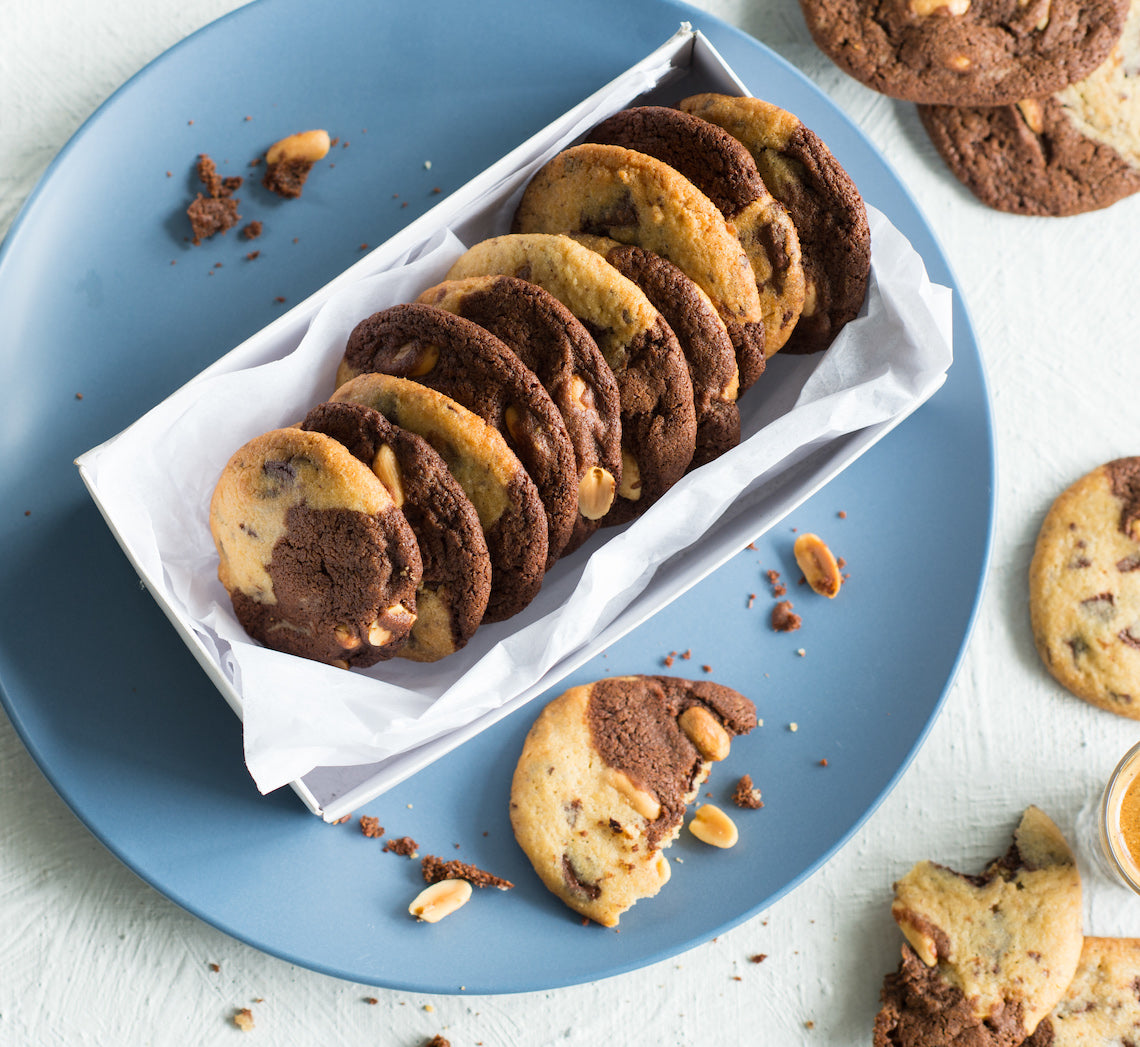
Prep 30min (+10min chilling time)
Bake 12min (per batch)Makes about 36
These clever cookies are the hybrid of a brownie and a chocolate chip cookie – dark, rich and chewy on one side and crisp, simple and familiar on the other. The perfect cookie really!
Ingredients
Chocolate chip cookie dough
125g butter, softened
110g (½ cup) granulated white sugar
55g (¼ cup, firmly packed) brown sugar
1 teaspoon natural vanilla essence or extract
1 egg, at room temperature
185g (1¼ cups) plain flour
½ teaspoon baking powder
125g good-quality dark chocolate chips or coarsely chopped chocolate (45-54% cocoa)
Salted peanut brownie dough
125g good-quality dark chocolate (45-54% cocoa), chopped
100g butter, cubed
165g (¾ cup, firmly packed) brown sugar
1 egg, at room temperature
1 teaspoon natural vanilla essence or extract
150g (1 cup) plain flour
½ teaspoon bicarbonate of soda
100g salted roasted peanuts
Method
- Preheat the oven to 180°C (160°C fan-forced). Line a large oven tray with non-stick baking paper.
- To make the Chocolate Chip Cookie Dough, use an electric mixer to beat the butter, sugar and vanilla until pale and creamy. Add the egg and beat well. Sift together the flour and baking powder, add to the butter mixture with the chopped chocolate and mix on the lowest possible speed until just evenly combined. Cover and place in the fridge while making the salted peanut brownie dough.
- To make the Salted Peanut Brownie Dough, put the dark chocolate and butter in a medium heatproof bowl over a saucepan of simmering water (make sure the base of the bowl doesn’t touch the water). Use a metal spoon to stir occasionally over low heat until just melted and smooth. Transfer to a large bowl and cool slightly. Use a balloon whisk to stir the sugar, egg and vanilla into the chocolate mixture until well combined. Sift together the flour and bicarbonate of soda, add to the chocolate mixture with the peanuts and use a wooden spoon to stir until evenly combined. Cover and place in the fridge to chill for 10 minutes or until the same consistency as the chocolate chip cookie dough.
- Take half a tablespoonful of both doughs and roll them together into a ball, keeping the different colours separate. Place on the lined tray, with the join between the two doughs running down the centre. Flatten to about 4cm in diameter and 1cm thick. Repeat to fill the tray, leaving about 5cm between the cookies.
- Bake in for 12 minutes or until the chocolate chip half is golden and cooked through and the brownie halves are still slightly soft to touch. Cool on the tray. Repeat with the remaining cookie doughs in two more batches.
Baker's Tips
- These cookies will keep in an airtight container at room temperature for up to 5 days – the longer they are kept the softer they will become.
Photography by Alan Benson.
This recipe is from Anneka's SBS Food online column, Bakeproof: Brownies.
CLICK HERE for more Bakeproof columns and recipes.
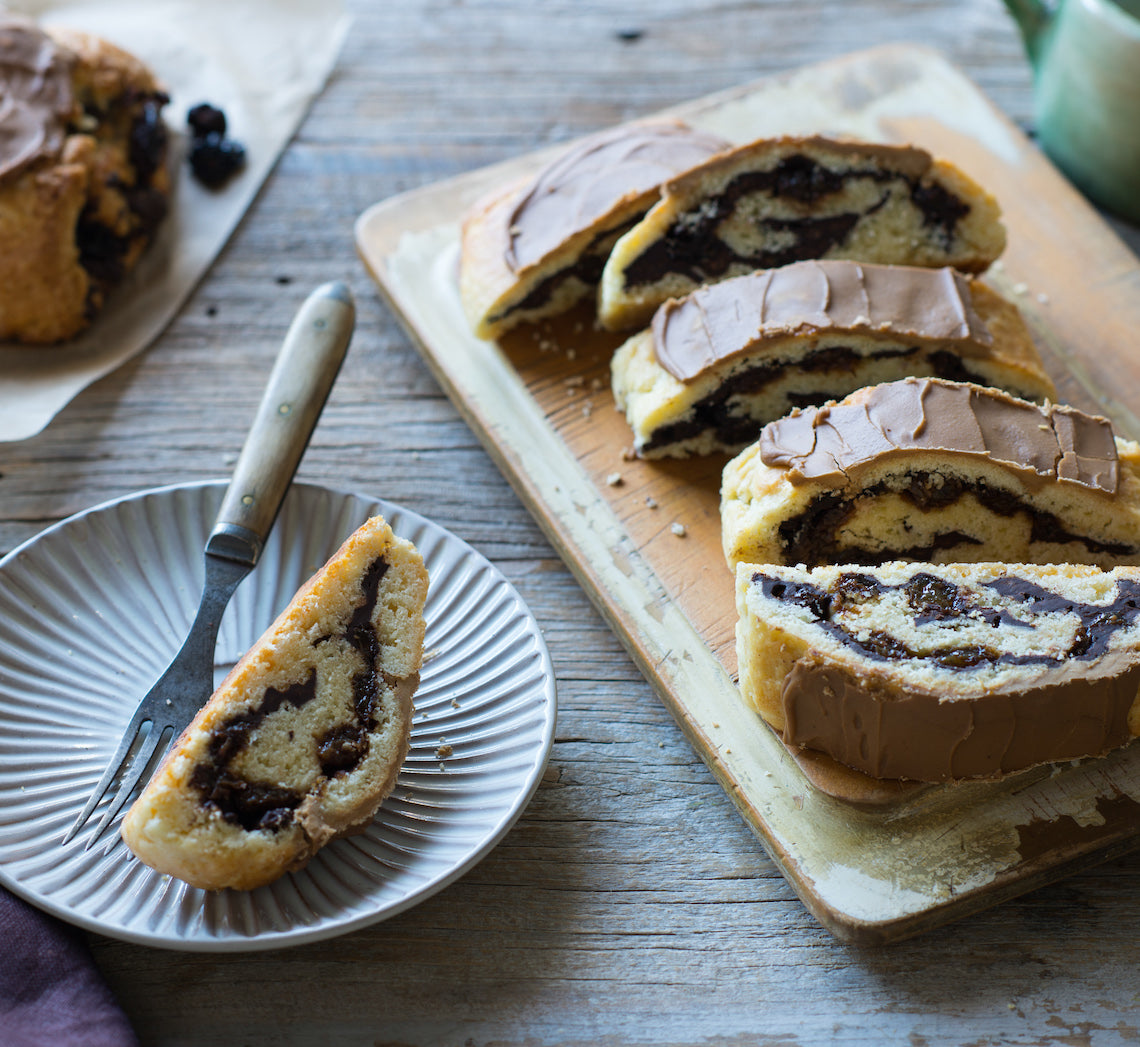
Prep 30min (+30min standing time)
Bake 40min Makes about 24
Even though these rolls are based on a scone dough, they resemble more a cakey biscuit. Confused? Just go ahead and bake them, you won't be disappointed… And you'll probably find yourself sneaking an extra slice!
Ingredients
170g (1 cup) seedless raisins
60ml (¼ cup) freshly brewed strong coffee
225g (1½ cups) self–raising flour
75g (½ cup) plain flour
Pinch of salt
80g butter, softened slightly, cubed
2 tablespoons caster sugar
125ml (½ cup) pure (pouring/thin) cream
80ml (⅓ cup) milk, plus extra for glazing
150g good-quality dark chocolate, chopped
Coffee icing
125g (1 cup) pure icing sugar
1 tablespoon freshly brewed strong coffee
Method
- Preheat the oven to 180°C (160°C fan-forced). Line a large baking tray with non–stick baking paper.
- Put the raisins and coffee in a small saucepan and bring to a simmer over medium heat. Remove from the heat and set aside for 15 minutes or until almost all the liquid has been absorbed. Drain the raisins and set aside.
- Sift both the flours and salt together into a medium bowl. Use your fingertips to rub in the butter until the mixture resembles fine breadcrumbs and the butter is evenly incorporated. Stir in the sugar and make a well in the centre. Combine the milk and cream, add to the flour mixture and use a flat-bladed knife to mix with a cutting action until the dough comes together in clumps.
- Use lightly floured hands to bring the dough together – it will be soft, but not sticky. Place on a lightly floured surface and knead lightly and briefly (only about 6 times) to bring it together in a smooth ball. Use a lightly floured rolling pin to roll the dough into a rectangle about 32 x 28cm. Sprinkle the dough with the chocolate and then the soaked raisins, leaving a 1cm border. Starting from a long side, roll up the dough to form a log. Cut in half and then place both logs on the lined oven tray, leaving enough room between each for spreading. Brush the surface of the logs with the extra milk to glaze.
- Bake in preheated oven for 40 minutes or until golden and cooked through and the logs sound hollow when tapped on the base. Remove from the oven and transfer the logs to a wire rack to cool.
- To make the Coffee Icing, put the icing sugar in a medium bowl and stir in the coffee to make a smooth pouring consistency. Drizzle over the cooled logs. Set aside for 15 minutes or until the icing sets before slicing.
Baker's Tips
- These rolls will keep in an airtight container at room temperature for up to 4 days.
This recipe is from Anneka's SBS Food column, Bakeproof: Scones.
CLICK HERE for more Bakeproof recipes.
Photography by Alan Benson.
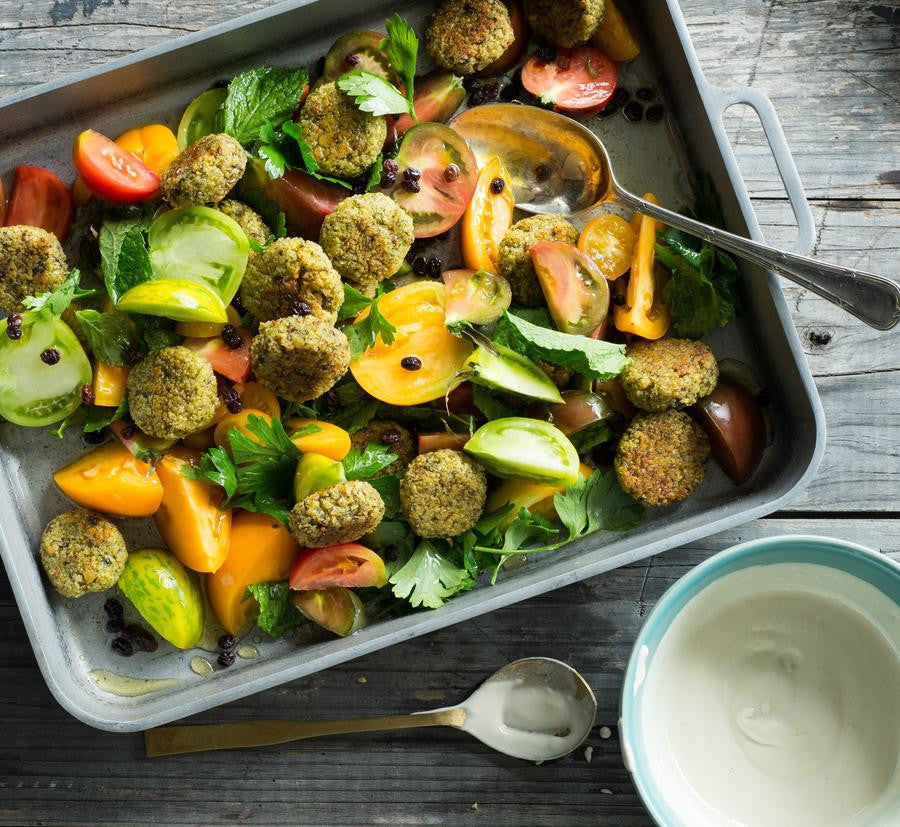
Prep 30minBake 20min Makes 6 serves
Traditionally deep-fried, this lighter version of the much-loved Middle Eastern falafel is baked. Teamed with a fresh herb and tomato salad and tasty tahini dressing, it makes a deliciously light meal.
Ingredients
lemon wedges, to serve
Baked falafel
80ml (⅓ cup) olive oil
300g dried chickpeas, soaked in water for 12-24 hours (see Baker’s tips)
1 cup coarsely chopped flat-leaf parsley
½ cup coarsely chopped coriander
½ cup coarsely chopped mint leaves
6 green shallots, white and pale green part only, sliced
1 garlic clove, crushed
2 tablespoons cumin seeds, toasted
2 teaspoons ground coriander
pinch cayenne pepper
½ teaspoon bicarbonate of soda
¾ teaspoon salt
½ teaspoon freshly ground black pepper
2 tablespoons lemon juice
Tahini sauce
135g (½ cup) tahini (see Baker’s tips)
120-140ml water
1 small garlic clove, crushed
1 tablespoon lemon juice
130g (½ cup) Greek-style natural yoghurt
Tomato & herb salad
500g mixed ripe tomatoes, halved or quartered, depending on the size
⅔ cup flat-leaf parsley leaves
⅔ cup small mint leaves
55g (⅓ cup) currants, soaked in boiling water for 10 minutes and drained
¼ teaspoon sugar
Method
- Preheat oven to 200°C (180°C fan-forced). Brush a large oven tray generously with half the oil.
- To make the baked falafel, place all the ingredients, except the remaining oil, in a food processor and use the pulse button to process until well combined and a rough paste forms. To test if it has been processed enough, press a little of the mixture in your hands. If it holds together, it is ready; if not, process for another 10 seconds and test again.
- Shape tablespoonfuls of the mixture into balls, massaging and pressing with your palms so the mixture holds together. Flatten slightly to form patties about 1 cm thick and 4 cm in diameter. Place on the oiled tray close together. Brush the patties generously with the remaining oil.
- Bake for 15 minutes, then turn the patties over and bake for a further 5 minutes or until golden and crisp on the outside and warmed through.
- Meanwhile, to make the tahini sauce, put the tahini in a medium bowl and gradually stir in the water (it will become thicker before it starts to thin). Stir through the yoghurt, garlic and lemon. Season well with salt and pepper. Cover and chill until required.
- To make the tomato & herb salad, put all the ingredients in a bowl and toss gently to combine.
- Divide the salad among serving plates, top with the falafel and drizzle with the tahini sauce.
Baker's Tips
Remember different batches of dried chickpeas will need various soaking times - the easiest way to tell when they’re ready to use is that they will crush easily when pressed between your fingers.
Use hulled (as opposed to unhulled) tahini to make your sauce for a less bitter flavour.
Photography by Alan Benson. Styling by Sarah O'Brien. Food preparation by Tina McLeish.
This recipe is part of our Bakeproof: Lebanese column.
View previous Bakeproof columns and recipes here.
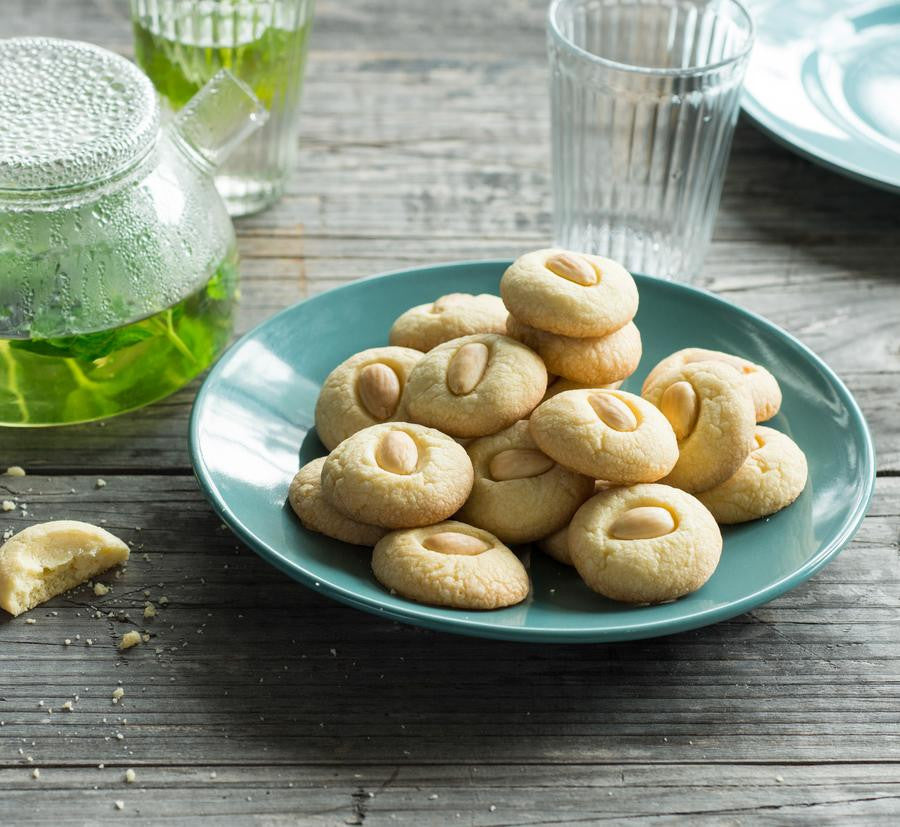
Prep 20minBake 20minMakes about 30
These simple shortbread-like biscuits, subtly scented with orange blossom water, are incredibly more-ish. They are just as good when flavoured with vanilla or rosewater, to taste, too.
Ingredients
125g (4½oz) salted butter, softened
90g (¾ cup) icing sugar, sifted
1 tablespoon orange blossom water, or to taste
200g (1⅓ cup) plain flour, sifted
30 whole blanched almonds
Method
- Preheat oven to 160°C/315°F (140°C/285°F fan-forced). Line two baking trays with non-stick baking paper.
- Use an electric mixer to beat the butter, icing sugar and orange blossom water until pale and creamy. Add the flour and mix on lowest possible speed until just combined and forms a dough.
- Roll 2 teaspoonfuls of the mixture into balls and place on the lined trays. Press a whole almond into each biscuit to flatten slightly.
- Bake the biscuits for 20 minutes, swapping the trays halfway through baking, or until pale golden and cooked through. Cool on the trays.
Baker's Tip
- These biscuits will keep in an airtight container for up to 1 week.
This recipe is from Anneka's SBS Food online column, Bakeproof: Lebanese Baking.
CLICK HERE for more Bakeproof recipes.
Photography by Alan Benson.
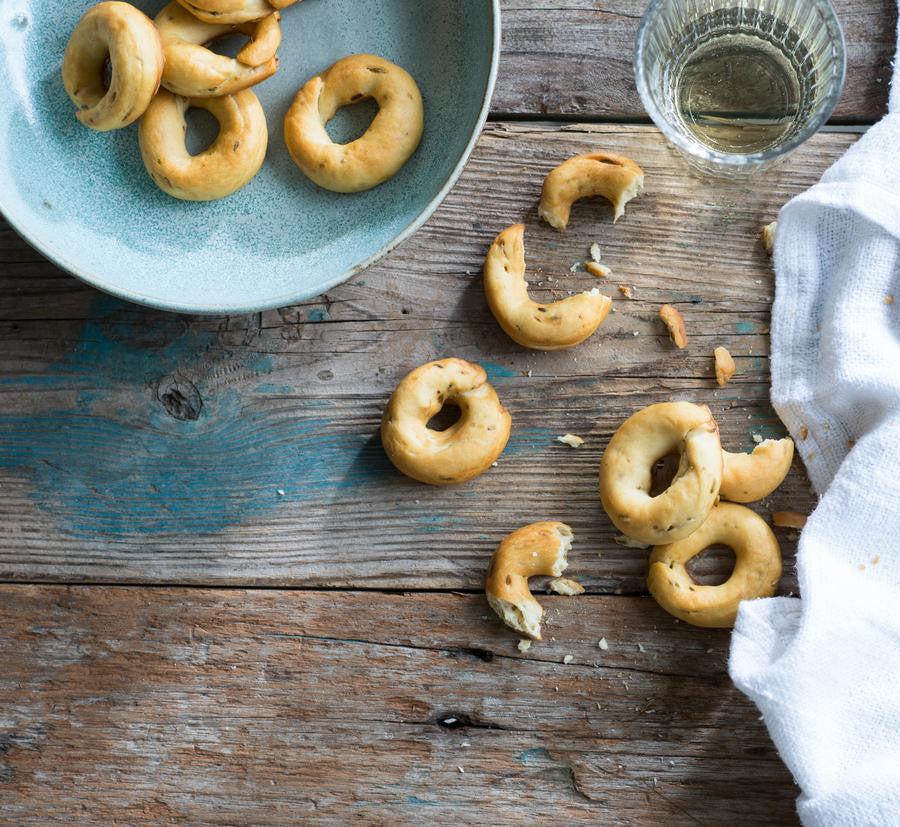
Prep 50min (+1hr 30min proving time)Bake 1hr 5minMakes about 36
Traditionally served as a stuzzichini (an appetiser snack), these cute, crisp, fennel-scented biscuits hail from the Puglia region in the heel of Italy’s boot. Traditionally associated with Easter you will also often find them served throughout the year alongside an aperitif for dunking.
Ingredients
80ml (⅓ cup) lukewarm water
1 teaspoon dried yeast
60ml (¼ cup) extra virgin olive oil
60ml (¼ cup) dry white wine
300g (2 cups) bread or pizza flour, plus extra to dust (see Baker's Tips)
1 tablespoon fennel seeds, coarsely crushed
1 teaspoon freshly ground black pepper
1 teaspoon salt
1 tablespoon bicarbonate of soda
Method
- Combine the water and yeast in a jug, stir to combine and set aside in a warm draught-free place for 5 minutes or until frothy.
- Add the olive oil and wine to the yeast mixture. Combine the flour, fennel seeds, pepper and salt in a large bowl, make a well in the centre and add the yeast mixture. Use a wooden spoon and then your hands to mix to a soft dough. Turn the dough onto a lightly floured surface and knead for 5-8 minutes or until it is smooth and elastic and springs back when you push your finger into it.
- Place the dough in an oiled bowl, turning it to coat lightly with the oil. Cover with plastic wrap and place in a warm, draught-free place for 1 hour or until almost doubled in size.
- Line two large oven trays with non-stick baking paper.
- Knock back the dough by punching it in the centre with your fist. Turn onto a lightly floured surface and knead for 1-2 minutes or until it returns to its original volume.
- Divide the dough into 12 even portions. Roll each portion into a rope about 30cm long and then cut each into three shorter lengths, each about 10 cm long. Roll each length until 15cm long. Join the ends of each length, pinching to seal, to form rings. Place on the lined oven trays, leaving a little room for rising between each, cover with plastic wrap or a slightly damp tea towel and set aside in a warm, draught-free place for about 30 minutes or until well puffed.
- Preheat oven to 180°C (160°C fan-forced). Fill a large saucepan or large deep frying pan with water until about 8cm deep. Add the bicarbonate of soda and bring to the boil.
- Reduce the heat so that the water is simmering. Working quickly, carefully add 6 of the rings to the boiling water. Once they rise to the surface (this will only take a few seconds) use a slotted spoon to transfer the rings, one at a time, back to the lined oven trays, allowing any excess water to drain away. Repeat with the remaining rings in 5 more batches.
- Bake in preheated oven for 25 minutes or until dark golden, swapping the trays after 12 minutes. Reduce the oven temperature to 110°C (90°C fan-forced) and continue to bake for a further 40 minutes, swapping the trays after 20 minutes, or until crisp all the way through. Cool on the trays.
Baker's Tips
- Bread and pizza flour (also known as ‘strong’ flour) has a higher gluten-content than regular plain flour. This type of flour is more suited to use in yeast-based bread recipes like these biscuits and will give you a better texture that will have more ‘bite’ rather than a fine cake-like crumbly texture.
- These biscuits will keep in an airtight container at room temperature for up to 2 weeks.
- The butter for this recipe needs to be soft enough to spread but not so soft that is starts melting when you spread it.
- This bread is best eaten on the day it is made but will keep in an airtight container for up to 2 days.
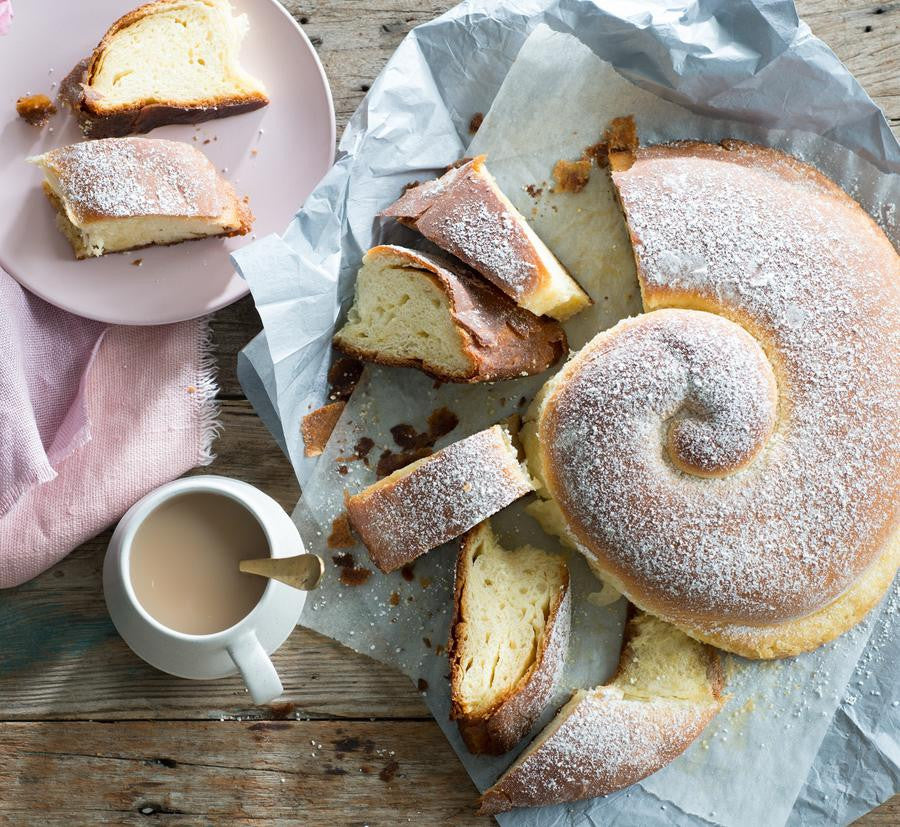
Prep 50min (+10min cooling, 15min chilling and 2hrs proving time)Bake 30minMakes 12 serves
This amazing Spanish bread is reminiscent of the croissant from neighbouring France – traditionally layered with lard (although I make mine with butter) this brioche-like bread has a wonderful flakiness and rich buttery flavour that is simply too hard to resist. Originally from the Isle of Mallorca it is traditionally served at festivals and celebrations such as Easter however, these days, it is often found on the breakfast table – trust me, it really is too good to keep for special occasions!
Ingredients
200ml (7fl oz) lukewarm milk
1 x 7g sachet (2 teaspoons) instant dried yeast
110g (½ cup/4oz) caster sugar
2 eggs, at room temperature
450g (3 cups/15¾oz) strong bread or pizza (high-protein) flour, plus extra to dust (see Baker's Tips)
¼ teaspoon fine salt
Melted butter, to grease
200g (7oz) salted butter, cubed, softened (see Baker’s Tips)
Icing sugar, to dust
Method
- Combine the milk, yeast and 1 teaspoon of the sugar in a jug. Stir to combine and set aside in a warm draught-free place for 5 minutes or until frothy. Add the eggs and use a fork to whisk to combine.
- Combine the flour, remaining sugar and salt in the bowl of a stand mixer. On low speed gradually add the milk mixture and knead with a dough hook. Continue to knead on low speed for 6-8 minutes or until the dough is smooth and elastic.
- Brush a medium bowl with melted butter to grease. Place the dough in the bowl, turning it to coat lightly with the butter. Cover with plastic wrap and place in a warm, draught-free place for 1 hour or until doubled in volume.
- Line a large oven tray with non-stick baking paper.
- When the dough has doubled in size knock it back by punching it in the centre with your fist. Turn onto a lightly floured surface and knead for 1-2 minutes or until it returns to its original volume.
- Use a lightly floured rolling pin to roll out the dough on a lightly floured surface to a 45cm/18in square. Working quickly, use a palette knife to carefully spread the butter all over the dough to cover evenly, leaving a 2cm/¾in border. Roll up the dough into a roll to enclose the butter and then press the ends to seal. With an end closest to you, gently roll out the dough again to a rectangle about 60cm/24in long and 15cm/6in wide, dusting the dough with a little flour if the butter breaks through. Starting from a long end, roll up the dough again to form a long roll.
- Loosely coil the roll onto the lined baking tray. Cover with a slightly damp tea towel and chill for 15 minutes. Remove form the fridge and set aside in a warm draught-free place for 1 hour or until well risen.
- Preheat oven to 180°C/350°F (160°C/315°F fan-forced).
- Bake the Ensaïmada in preheated oven for 30 minutes or until cooked through and golden. Place the baking tray on a wire rack and set aside on the tray for at least 10 minutes to cool slightly before serving warm or cool completely. Serve dusted liberally with icing sugar.
Baker's Tips
- The butter for this recipe needs to be soft enough to spread but not so soft that is starts melting when you spread it.
- This bread is best eaten on the day it is made but will keep in an airtight container for up to 2 days.
This recipe is from Anneka's SBS Food online column Bakeproof: Easter Treats. Click here for more Bakeproof columns and recipes.
Photography by Alan Benson.
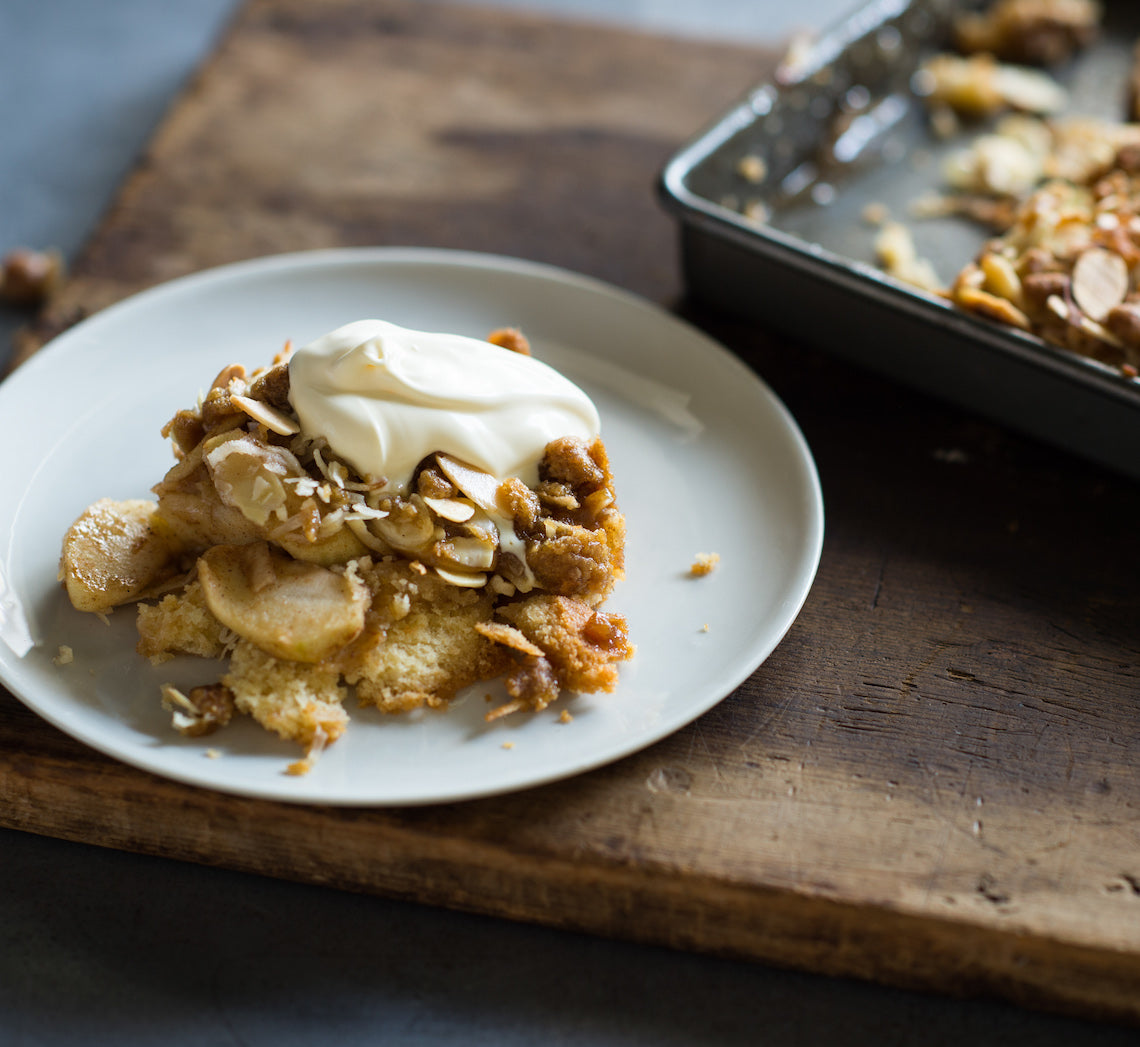
Prep 25minBake 35minMakes 8-10 serves
With its shortbread-like base, tart apple filling and crunchy crumble topping, this is a slice that you eat with a fork or spoon, not your fingers. It's more suited to dessert than afternoon tea... although, by all means, feel free to indulge mid-afternoon!
Ingredients
melted butter, to grease
800g apples (such as Granny Smith or Golden Delicious)
75g (⅓ cup) caster sugar
1½ teaspoons ground cinnamon
thick cream or vanilla ice cream, to serve
Base
190g (1¼ cup) plain flour
1 teaspoon baking powder
110g (½ cup) caster sugar
125g unsalted butter, cubed, softened
1½ teaspoons natural vanilla essence or extract
1 egg
50g (⅓ cup) plain flour
100g (½ cup, firmly packed) brown sugar
80g chilled unsalted butter, cubed
40g (½ cup) shredded coconut
75g (¾ cup) flaked almonds
Method
- Preheat the oven to 180°C. Brush a 20 x 30cm shallow slice tin with melted butter to grease.
- To make the Base, put the flour, baking powder, sugar and butter in the bowl of a food processor and process until the mixture resembles breadcrumbs. Whisk the egg with the vanilla, add to the flour mixture and use the pulse button to process until the mixture forms a soft dough. Bring together with your hands and then press the dough evenly over the base of the greased tin to evenly cover. Place in the fridge.
- Meanwhile, to make the Crumble Topping, put the flour and brown sugar in a medium bowl and use your fingertips to rub in the butter until roughly combined. Stir in the coconut and almonds.
- Peel, core and thinly slice the apples and put in a large bowl. Combine the sugar and cinnamon, sprinkle over the apples and toss to coat evenly. Arrange the apple slices over the Base in the tin and then sprinkle evenly with the Crumble Topping. Set aside.
- Bake in preheated oven for 30-35 minutes or until the base is cooked, the Crumble Topping is golden, the apples are tender when tested with a skewer, and the base is cooked through.
- Serve warm or at room temperature cut into portions and accompanied by cream or ice cream.
Baker's Tips
- This slice is delicious served either warm or at room temperature. It will keep, covered, in the fridge for up to 3 days. Bring to room temperature or warm gently in the microwave to serve.
This recipe is from Anneka's SBS Food online column, Bakeproof: Apples. CLICK HERE for more Bakeproof recipes.
Photography by Alan Benson.






